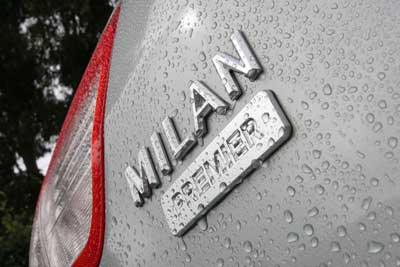Recent Articles
Popular Makes
Body Types
2006 Mercury Milan Review
Mercury adds a sexier name to the Ford Fusion
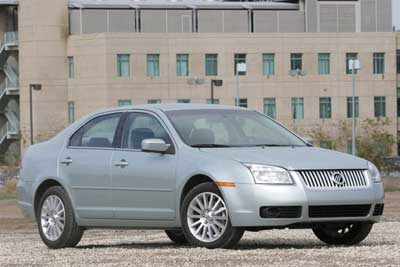
When a name is all that distinguishes your product, there’s a problem. Sure, it may work for the talentless hack that sells under the name Paris Hilton, but usually there’s more substance to a saleable good than a “That’s hot” tagline from a waif with a hollow smile. At least that’s what my girlfriend says, the same woman who has been targeted by Mercury as the intended buyer of its 2006 Milan sedan. Milan. It’s a name that conjures up thoughts of rich history, elegance, romance, and yes, malnourished runway models struggling to remain upright and, well, walk, as they show off the fashion world’s premier designs. Yet, unlike the liquid lunches of these skeletal beauties, there’s a lot that goes into building brands like Versace, Gucci, and Prada – it’s not as easy as going to Malaysia and having a kid in a sweat shop stitch a fancy label on a GAP shirt. However, there are “Gucce” and “Proda” makers out there looking to give buyers upper-crust living at Wal-Mart prices. Such is the case with the 2006 Mercury Milan, an attractive yet unassuming sedan that features above-average interior materials, decent optional leather, a comfortable cabin, and a competent powertrain. Problem is, this ride is little more than a gussied-up Ford Fusion, a vehicle offered with comparable amenities and a lower sticker price. It’s a Thomas Kincaid selling in a gallery featuring much more desirable works from Raphael and Michelangelo. In car speak, that means companies like Honda and Toyota are selling better cars, though the Mercury does have its merits. Power for the front-wheel-drive 2006 Mercury Milan comes from a 2.3-liter, dual overhead cam, 16-valve four-cylinder engine generating 160 horsepower at 6,250 rpm and 156 lb.-ft. of torque at 4,250 rpm mated to a five-speed manual or optional five-speed automatic transmission. However, for more performance, shoppers can opt for the 3.0-liter, dual overhead cam, 24-valve V6 pushing 221 horsepower at 6,250 rpm and 205 lb.-ft. of torque at 4,800 rpm. A six-speed automatic is standard with the six-cylinder engine. Fuel economy for the smaller motor ranges between 21 mpg city/31 mpg highway with the stick shift and 24 mpg/32 mpg with the automatic; EPA estimates for the V6 are 21 mpg city and 29 mpg highway. All versions use vented front and solid rear disc brakes to stop, ride on a short- and long-arm front and multi-link rear suspension, and track with a rack-and-pinion steering system. What’s featured inside the 2006 Mercury Milan depends on the model chosen. The base model sells for $18,995, including a $650 destination charge, and includes air conditioning, a CD and MP3 player, power door locks and windows, 16-inch steel wheels rolling on 205/60 tires, heated mirrors, a rear 60/40 split bench seat, a power driver’s seat, cruise control, a tilt and telescoping steering wheel, steering wheel controls, and a trip computer. Move up to the $21,995 Premier for standard 17-inch alloy wheels wrapped in 225/50 rubber, a six-disc CD changer, leather seats, antilock brakes, and electronic brake force distribution. Entry-level Milan V6 models carry a sticker price of $20,890 and feature the same equipment as the base version, adding the 221-horsepower engine, the six-speed automatic transmission, and 16-inch alloy wheels. For $23,495, the Premier V6 mirrors the Premier four-cylinder except for the powertrain. Options include a five-speed automatic transmission for four-cylinder models, upgraded wheel and radio packages, antilock brakes for base models, and traction control on V6 models. Milan Premiers can also be outfitted with heated front seats, a Comfort and Security Package which includes items like automatic climate control and puddle lamps on the mirrors, and a Safety Package that adds front side and side-curtain airbags. Our staff spent a week during the mild southern California winter running errands, commuting along congested highways, and playing Bury the Tachometer Needle on twisty back roads in a 2006 Mercury Milan Premier V6 decked out with the optional Comfort and Safety packages, heated seats, traction control, and an upgraded Audiophile sound system. With the $650 destination charge included, our tester had a sticker price of $25,495.
Driving Impressions
Thom Blackett’s 2006 Mercury Milan Driving Impressions: Frankly, driving a V6-powered Mercury sedan for a week wasn’t a prospect that got my blood pumping, especially when I saw our Grandma Green tester sitting in the lot. However, after a few miles behind the wheel, the 2006 Milan proved to me once again that it’s a bad idea to judge a book by its cover. With 221 horsepower on tap, the 2006 Mercury Milan has plenty of power for all driving situations, and the engine offers some impressive grunt when the revs climb a bit. Those expecting to smoke Hemi-powered Chryslers will be rewarded with disappointment, but passing one at a quick clip on the highway is an easy exercise. The six-speed transmission is marked by highs and lows – thumbs up for its tendency to hold gears longer for better acceleration and smooth shifts, but subtract points for the tranny’s habit of hunting for gears in stop-and-go traffic. While you’re at it, knock a few off for the as-tested fuel economy result of 17.6 mpg and the engine’s unrefined demeanor when pushed hard. During those aggressive stints, the Milan exhibited its share of body roll and tire squeal from the 17-inch Michelins, though the ride was tighter than one might expect from a premium domestic sedan. You can take corners at speed with few worries, because the tires yell a warning when they’re nearing their threshold of grip, and the steering is surprisingly tight and responsive for a car in this class. The suspension offers a comfortable compromise between sporty and luxury by swallowing bumps at slow speeds with no ill effects, though the ride does get a bit unsettled when hitting those irregularities at 40-50 mph. Competitors in this broad category are numerous, including the sportier Acura TSX, the more powerful Honda Accord V6, and the more refined Volkswagen Passat. Yet, as a driver’s car, the 2006 Mercury Milan does its best to hold its own with a capable powertrain and handling characteristics that verge on enjoyable. Ron Perry’s 2006 Mercury Milan Driving Impressions: It amazes me how two manufacturers can basically build the same car, yet they can be so completely different. In this case, I feel the Mercury Milan is a much better car than the Ford Fusion. There seems to be more attention paid to details, all of which heighten the driving experience. The Milan feels tighter and better built and is tuned to be more driver friendly, from the smoother ride to the handling capability. Ask the V6 to respond and it pulls hard, although as it climbs up the rev range it does get buzzy. Turn-in produces understeer, which is expected from a car of this nature, but for everyday driving it can still tackle a freeway on ramp and deliver some fun. Brake feedback was good for me but I found the steering to be on the light side – more road feel, please. Outward visibility to the rear was good as was the view out the side mirrors. The Milan is an easy car to navigate through traffic. Christian Wardlaw’s 2006 Mercury Milan Driving Impressions: Bad news for Mercury: my 32-year-old girlfriend, the single, educated, professional at which the 2006 Milan is aimed, did not like this car. She thought the engine sounded coarse and unrefined, she found the transmission to be unresponsive, she disliked the pedal feel, and she complained that the switchgear felt cheap. I asked her what, if she had the $25,000 and change our Milan Premier test car stickered for and she was buying a midsize sedan, she might choose instead. Her reply: “Can I get a Passat for that price?” There’s your bogey, Mercury. As for my opinion, I liked the Milan. Indeed, the transmission needs to lay off the Prozac, but otherwise this is a nice piece of work. The engine, if not class leading in terms of power and refinement, pulls with urgency the harder it’s revved and to my ear sounds good doing it. The steering is linear, responsive, and properly weighted. Ride quality lands smack dab between taut and soft, with just right amounts of road feel getting through the steering and suspension. Handling is good for a car like this, and though the Milan pushes wide when driven with verve through a curve, the tires howl little when taxed. Cruising on the highway, the Milan V6 is quiet, and gets good gas mileage. Visibility to the front and sides is good, but the rear deck is too tall – short cars following behind get lost from view. Another thing: make sure to leave plenty of space for U-turns, because the Milan’s turning circle is noticeably wide.

Comfort
Thom Blackett’s Opinion of the 2006 Mercury Milan’s Comfort: buy a Mazda Miata and rightfully expect some discomfort, but anything with a premium Mercury badge on it better be comfy. The 2006 Milan lives up to such demands, with generous front bucket seats providing sufficient lower leg support, wide backrests, and sizeable adjustable headrests. Side bolsters are appropriate for what this car will do in the corners, and the power seat bottom works with the tilt and telescoping steering wheel to provide the driver with a suitable traveling position. Padding on the center armrest and doors is easy on the elbows, and the soft plastic panels on the center console and doors are knee-friendly. Rear seat passengers are treated equally well, sitting on a well-cushioned split bench that features a natural recline position and a padded fold-down center armrest. With doors that open wide and proper hip points, getting in and out of the 2006 Mercury Milan is a cinch. What’s not so easy is using the driver’s manual lumbar support knob, as it requires a lot of hand strength to fully utilize. If over-70 grandparents are part of the intended sales demographic, you can be sure they won’t be happy with this strenuous activity. Ron Perry’s Opinion of the 2006 Mercury Milan’s Comfort: Finding a comfortable seating position was easy in the Milan. The seats and steering wheel have enough adjustments to get comfortable. Bolstering is okay for most individuals, but I like to feel held in by the seat and the Milan doesn’t offer that. Softer leather might also add to the seat comfort. A well-padded center console lid makes for a comfortable resting area for your right arm on long trips or when stuck in traffic. Designers also used soft-touch surfaces on the door panels and lower front dash. Hop in the back seat and you will find a spacious setting. Knee, foot and head room can’t be described as plentiful, but there is enough room for an average adult to ride in comfort.
Christian Wardlaw’s Opinion of the 2006 Mercury Milan’s Comfort: The 2006 Mercury Milan would make a great road tripper. The power adjustable seat and tilt/telescopic steering wheel make it easy to find a proper driving position, and with manual lumbar supports and heated front seats, the Milan soothes sore backs. Add in the softly padded and wide upper door panels, the soft-touch lower dash trim where the driver’s leg rests, and a steering wheel that is pleasing to hold, and the Milan likely makes for a great long distance machine. The rear seat, however, is not quite as impressive. It’s rather flat and low, but leg and foot room is generous, and the Milan Premier comes with a fold-down center armrest. My main complaint regarding the Mercury Milan’s comfort is with entry and exit. The door sills are very wide, and on more than one occasion I dragged my left leg across it getting in and out. That’s fine in Southern California where I live, but in places like Michigan where I grew up, that ruins your pants pretty quick because more often than not, those door sills are dirty from rain, snow, or mud.

Quality
Thom Blackett’s Opinion of the 2006 Mercury Milan’s Quality: Materials used to build the 2006 Mercury Milan appear to be of high quality, but the overall craftsmanship needs a little more attention. Inconsistent gaps are evident around the dash, panels on the rear of the center console are uneven, and the door window sills, A-pillar covers, and instrument panel all feel loose. The exterior was also marred by minor build quality problems, including differing gaps on the left and right side doors, lower rear doors that don’t fit flush with the body, and a tweaked trunk lid. Making up a bit for the build quality concerns were the padded, matte plastics with matching grains used throughout the interior, the leather that was sub-premium but perfectly acceptable for a $25,000 sedan, solid switchgear, and the durable hard plastics that were limited to less visible areas. Ron Perry’s Opinion of the 2006 Mercury Milan’s Quality: Details make the difference, and Mercury’s attention to detail helps give the Milan a luxury feel. Fit and finish is better than on the Ford Fusion and the trim pieces Mercury has chosen give the cabin a modern feel. No squeaks or rattles interfered with my drive and wind noise was minimal. The quality of the leather needs to be stepped up, though, to compete against others in this class. Outside fit and finish is better than expected and there were no loose or sloppy parts found on inspection. The lack of a trunk pull handle just doesn’t cut it on a car in this category, or in fact, on any car these days.
Christian Wardlaw’s Opinion of the 2006 Mercury Milan’s Quality: Sometimes, it’s too easy to see where FoMoCo beancounters went overboard to maximize the Milan’s profitability. Take, for instance, the exposed screwheads inside the door panel pulls, the cheap-feeling leather upholstery, the excess gloss to some of the interior’s bits and pieces, the lack of a handle on the inside of the trunk lid to assist with closing. But generally speaking, the Milan comes across as a convincingly upscale car, and is more refined than midsize entries from Chrysler, General Motors, Hyundai, Mitsubishi, and others.
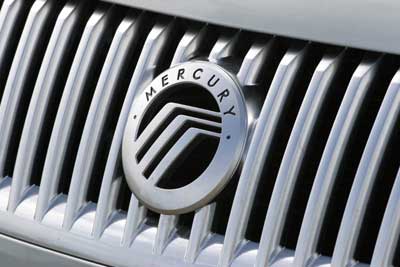
Design
Thom Blackett’s Opinion of the 2006 Mercury Milan’s Design: Mercury’s designers used a rather conservative pen on the Milan, the result being a traditional midsize sedan with smooth body lines and attractive alloy wheels. As such, there’s little to dislike and even less to get excited about. High points include the alloy look of the grille, the two-tone interior with the simple but pleasant instrument and dash layout, and the combination of a roomy, comfortable cabin with the utility of a generous trunk. Despite the positives, the 2006 Mercury Milan could benefit from a few visual changes and a bit more flair. Though smaller and more appealing than the lenses on the Lincoln Zephyr, the Milan’s mostly white taillights could use more character, a point that also rings true for the headlights. And from a distance, this car is virtually indistinguishable from countless other rental sedans – not exactly a winning formula for a car company fighting for survival. Ron Perry’s Opinion of the 2006 Mercury Milan’s Design: I actually like the look of the 2006 Mercury Milan. It takes on the appearance of other cars depending on the angle. From the front I can see elements of the last Ford T-Bird coupe (not the retro roadster) and as you come around the rear hints at Mercedes and Acura. The best and most distinctive feature of the exterior design has to be the grille. It really sets off the front of the car and gives it distinction. The multi-spoke wheel design also compliments the grille work. Sliding into the driver’s seat, I was impressed with the design of the interior, which immediately helped me overcome any preconceived impressions I had. Designers have used a two-toned color treatment accented with silver faux aluminum to give the Milan a modern, up-to-date feel. This treatment projects a feel of luxury and offers a nice balance. Furthermore, all of the controls are where they should be and are easy to operate. Christian Wardlaw’s Opinion of the 2006 Mercury Milan’s Design: Mercury’s distinguishing design characteristic is satin nickel trim. That’s about all that separates any given Merc from the Ford upon which it is based. Good thing it works. The logo on the front of the car is too big, but I like the way the vertically slatted grille mirrors the multi-spoke alloy wheels. In back, the trunk lid is decorated with a silver plastic trim piece that provides a good grip for closing the lid, but the frosted taillight lenses are a bit over the top. Inside, the Milan’s silver dash trim is nicer looking than the piano-black plastic Ford installs in the Fusion. Two-tone décor includes the dash and door panels, and the leather seats in our Milan Premier had contrasting inserts. Controls are simply marked and easy to find, but there are a few ergonomic glitches. The stereo offers no tuning knob, the climate controls are a bit fussy to use and are mounted too low on the center stack, and the driver’s window features one-touch down but not one-touch up. Also, the turn signal stalk is mounted at an odd angle, and I kept accidentally flashing the bright lights when trying to activate the blinkers.
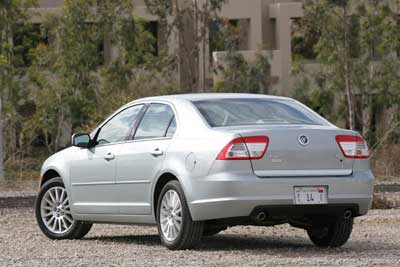
Advice
Thom Blackett’s Advice about the 2006 Mercury Milan: With all of the exceptional sedans on the market, the chances of shoppers finding a compelling reason to buy the 2006 Mercury Milan are slim to none. Having a competent powertrain, an attractive design, and a comfortable interior are barely enough to put a car on a buyer’s test-drive list; mediocre build quality, an uncompetitive three-year/36,000-mile powertrain warranty, and badge engineering will likely kill the Milan’s prospects before Joe Consumer’s butt even hits the seat. Granted, the Mercury offers a surprising bit of driving spirit and a hospitable interior, but similarly-priced competitors offer these traits and much more. Ron Perry’s Advice about the 2006 Mercury Milan: Two things would influence my decision about whether or not I would buy the Mercury Milan over a Japanese or Korean car – out-the-door price and warranty. It’s hard to beat the warranty Hyundai offers and Korean quality has improved by leaps and bounds, but you may be able to get a better deal on the Mercury. Does a lower up-front price beat out a longer warranty? And what about resale, at which the Japanese generally excel? Whatever your decision or preferences, the 2006 Mercury Milan is definitely worthy of a test drive.
Christian Wardlaw’s Advice about the 2006 Mercury Milan: Unfortunately, consumer attitudes are such that for Mercury, or any domestic automaker, to sell a car for close to sticker price, that car needs to deliver the style, refinement, content, durability, resale value, and prestige of comparable models from Honda, Nissan, or Toyota. And with the handsome new 2006 Hyundai Sonata and redesigned 2006.5 Kia Optima priced about the same as equivalent Milans, but with a much better warranty package, it’s no surprise that Mercury dealers are already offering deep discounts on this capable sedan. That’s too bad, because the 2006 Mercury Milan is a solid effort, pleasing to drive, attractive, comfortable, roomy, and useful. But it’s fighting an uphill battle, and losing to the known-quantity reputations of the major Japanese brands, the reassuring warranty coverage offered by the upstart Koreans, and the continued prestige associated with Volkswagen. Somebody in Detroit might think satin-nickel trim will do the trick, but it’s going to take more than shiny silver to resuscitate Mercury’s sales.
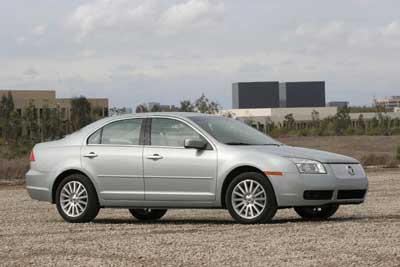
Specifications
Test Vehicle: 2006 Mercury Milan Premier V6 Price of Test Vehicle: $25,495 (including a $650 destination charge) Engine Size and Type: 3.0-liter V6 Engine Horsepower: 221 at 6,250 rpm Engine Torque: 205 lb.-ft. at 4,800 rpm Transmission: Six-speed automatic Curb weight, lbs.: 3,303 EPA Fuel Economy (city/highway): 21/29 mpg Observed Fuel Economy: 17.6 mpg Length: 191.4 inches Width: 72.2 inches Wheelbase: 107.4 inches Height: 55.8 inches Leg room (front/rear): 42.3/37.0 inches Head room (front/rear): 38.7/37.8 inches Max. Seating Capacity: Five Max. Cargo Capacity: 15.8 cubic feet Competitors: Acura TSX, Buick LaCrosse, Chevrolet Impala, Chevrolet Malibu, Chrysler Sebring, Dodge Stratus, Ford Fusion, Honda Accord, Hyundai Azera, Hyundai Sonata, Kia Amanti, Kia Optima, Mazda 6, Mitsubishi Galant, Nissan Altima, Nissan Maxima, Pontiac G6, Pontiac Grand Prix, Subaru Legacy, Suzuki Verona, Toyota Camry, Volkswagen Jetta, Volkswagen Passat, Volvo S40
Photos courtesy of Ron Perry
